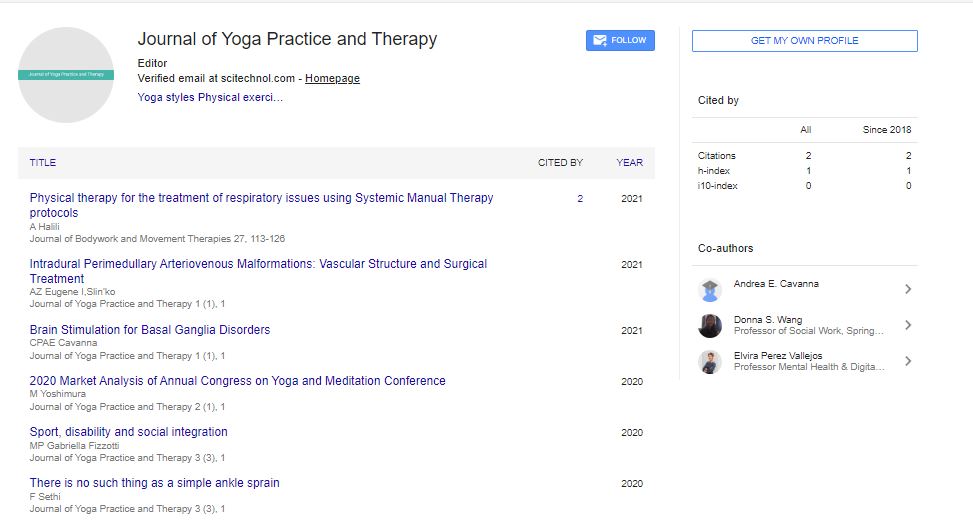Opinion Article, Vol: 6 Issue: 1
Meditation for Mindfulness in the Management of Chronic Pain
Christine Lin*
Department of Neurosurgery, University of California, 200 W. Arbor Drive 8893, USA
*Corresponding Author: Sriloy Mohanty
Department of Neurosurgery, University of California, 200 W. Arbor Drive 8893, USA
E-mail: Christine@health.ucsd.edu
Received date: 27 February, 2023, Manuscript No JYPTY-23-94049;
Editor assigned date: 01 March, 2023, Pre QC No. JYPTY-23-94049(PQ);
Reviewed date: 15 March, 2023, QC No. JYPTY-23-94049;
Revised date: 22 March, 2023, Manuscript No. JYPTY-23-94049(R);
Published date: 29 March, 2023, DOI: 10.4172/jypty.1000112
Citation: Lin C (2023) Meditation for Mindfulness in the Management of Chronic Pain. Int J Yoga Therap 6:1.
Description
Meditation is a practice that can be helpful in managing chronic pain through mindfulness. Mindfulness meditation involves paying attention to the present moment, without judgment or distraction, and accepting current state of being. This can be particularly useful for people with chronic pain, who may experience a range of emotions, including frustration, anxiety, and depression. Find a comfortable and quiet place to meditate will not be disturbed. Begin by focusing on breath. Take a few deep breaths and then breathe naturally. Notice the sensation of the air moving in and out of body. If experience any physical sensations or thoughts, simply acknowledge them and then return focus and breath.
As continue to meditate, may begin to notice sensations in the body that are related to chronic pain. Allow to feel these sensations without judgment or resistance. Just observe them and notice how they change over time. As meditate, may also become aware of any emotions that arise in response to pain. Again, simply observe these emotions without judgment or resistance. The mind becomes distracted, gently bring focus back to breath. This is a natural part of the meditation process, and it is normal for mind to wander. Aim to meditate for 10-15 minutes per day, gradually increasing the duration become more comfortable with the practice.
By practicing mindfulness meditation regularly, it may find that was better able to manage the chronic pain, reduce stress and anxiety, and improve overall well-being. However, it is important to note that mindfulness meditation should not be used as a substitute for medical treatment, and always consult with healthcare provider before starting any new treatment program. Chronic pain is a complex medical condition that affects millions of people worldwide. Managing chronic pain can be challenging, but there are several approaches that can help alleviate the pain and improve the patient's quality of life.
Management strategies for chronic pain
Medication: Medications are often the first line of treatment for chronic pain. Painkillers, anti-inflammatory drugs, and muscle relaxants are commonly used to manage pain. However, it's important to use these medications under the supervision of a healthcare provider as they can have potential side effects.
Physical therapy: Physical therapy is an effective way to manage chronic pain. A physical therapist can work with the patient to develop a personalized exercise program that can help reduce pain, improve flexibility, and strengthen the affected areas.
Cognitive-behavioral therapy: Chronic pain can be emotionally and mentally draining. Cognitive-behavioral therapy (CBT) is a type of talk therapy that can help patients learn coping skills and techniques to manage their pain. It can also help them identify and change negative thoughts and behaviors that may be contributing to their pain.
Mind-body techniques: Mind-body techniques such as meditation, yoga, and tai chi can help manage chronic pain by reducing stress and promoting relaxation. These techniques can also help patients develop a greater sense of control over their pain.
Acupuncture: Acupuncture is a complementary therapy that involves inserting thin needles into specific points on the body. It's believed to stimulate the release of endorphins, which are the body's natural painkillers.
Transcutaneous Electrical Nerve Stimulation (TENS): TENS is a therapy that uses a small device to deliver electrical impulses to the affected area. It's believed to disrupt the pain signals traveling to the brain, which can reduce pain.
Surgery: In some cases, surgery may be necessary to manage chronic pain. However, surgery is typically only recommended after other non-invasive treatments have been tried.
It's important for patients to work with their healthcare provider to develop a personalized treatment plan for managing chronic pain. The treatment plan may involve a combination of these strategies or others, depending on the patient's specific needs and the underlying cause of their pain.
 Spanish
Spanish  Chinese
Chinese  Russian
Russian  German
German  French
French  Japanese
Japanese  Portuguese
Portuguese  Hindi
Hindi 